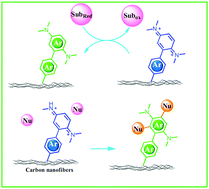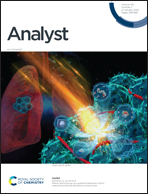Robust non-covalent and covalent anchored N,N,N′,N’-tetramethyl-p-phenylenediamine derivative on electrode surface via spontaneous physical immobilization and in situ generated aryldiazonium ion electro-grafting: implication for on-surface chemistry and electro-catalytic determinations†
Abstract
The two-electron oxidation of N,N,N′,N‘-tetramethyl-p-phenylenediamine (TMPD) results in highly unstable TMPD2+ in aqueous solutions. Despite its low redox potential, TMPD2+/TMPD couple is not considered as a suitable charge transfer functional group to modify the electrode due to instability of TMPD2+ in aqueous solutions. The main focus of the present paper is to fabricate an efficient redox-active electrode by coupling TMPD with 4-nitroaniline to be utilized for on-surface chemistry. The nitro functional group in the coupling product N2,N2,N5,N5-tetramethyl-4′-nitro-[1,1′-biphenyl]-2,5-diamine (MNPD) was reduced electrochemically to the corresponding amino derivative (MAPD). The oxidized form of MAPD (MAPD2+) exhibited high stability as well as low reduction potential in aqueous solutions. A redox active electrode was designed via the immobilization of the electro-generated MAPD onto a nanofibrillated mesoporous carbon (IFMC) modified glassy carbon electrode (GCE). The redox signal increased several folds with the deposition of IFMC onto glassy carbon electrode compared to bare GCE. Two functionalization routes, electro-grafting and spontaneous physical immobilization, were examined for the attachment of the redox species to the electrode surface. In the first approach, electro-grafting was attained via the electrochemical reduction of MNPD in the presence of sodium nitrite to produce diazonium ions in situ. The redox centers covalently grafted to the surface showed dense deposition and appreciable stability. In the second route, spontaneous adsorption was performed by the same strategy of electro-grafting in the absence of sodium nitrite. In this case, the hydrophobic nanofiber structure of IFMC was capable of robustly trapping MAPD. The anchored MAPD shows high reactivity in Michael addition reactions in ultrafast reaction times. The post-functionalization of the electrodes was easily performed by the oxidation of the redox centers in the presence of species with nucleophilic properties at the electrode/electrolyte interface. In addition, both the constructed electrodes are introduced as suitable mediators in electro-catalytic implications because of their reversibility, stability, and low oxidation potential. The electro-catalytic activity of the electrodes was established for the indirect electrochemical oxidation of homocysteine as a typical substrate.



 Please wait while we load your content...
Please wait while we load your content...